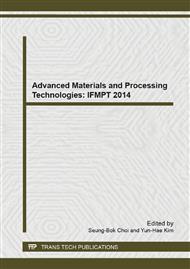[1]
E.O. Ezugwu, J. Bonney, Y . Yamane. An overview of the machinability of aeroengine alloys [J]. Journal of Materials Processing Technology. 2003(134): 233-53.
DOI: 10.1016/s0924-0136(02)01042-7
Google Scholar
[2]
Dudzinski D, Devillez A, Moufki A, et al. A review of developments towards dry and high speed machining of Inconel 718 alloy [J]. Machine Tools and Manufacture, 2004(44): 439-456.
DOI: 10.1016/s0890-6955(03)00159-7
Google Scholar
[3]
Changxu Shi, Hengde Li, Lian Zhou. Materials science and Engineering Handbook [M]. Beijing: Chemical Industry Press, 2004 (In Chinese).
Google Scholar
[4]
Herbert Schulz, Eberhard Abeled, Ning He. The theory and application of high speed machining [M]. Beijing: Science Press, 2010(In Chinese).
Google Scholar
[5]
Muammer Nalbant, Abdullah Altın, Hasan Go¨kkaya. The effect of cutting speed and cutting tool geometry on machinability properties of nickel-base Inconel 718 super alloys[J]. Materials and Design, 2007, (28): 1334-1338.
DOI: 10.1016/j.matdes.2005.12.008
Google Scholar
[6]
A. Altin, M. Nalbant, A. Taskesen. The effects of cutting speed on tool wear and tool life when machining Inconel 718 with ceramic tools [J]. Materials and Design, 2007, 28: 2518–2522.
DOI: 10.1016/j.matdes.2006.09.004
Google Scholar
[7]
J.P. Costes, Y. Guillet, G. Poulachon, et al. Tool-life and wear mechanisms of CBN tools in machining of Inconel 718[J]. International Journal of Machine Tools & Manufacture, 2007, 47: 1081-1087.
DOI: 10.1016/j.ijmachtools.2006.09.031
Google Scholar
[8]
Jun Zhao, Anhai Li ect. Study on tool life and cutting parameter optimization of Inconel 718[J]. Academic Journal of Harbin Polytechnic University, 2011, 16(1) : 9-12(In Chinese).
Google Scholar
[9]
Xinyu Song, Jun Zhao, Junling Jiang. The wear mechanism of ceramic tool when machining Inconel 718 [J], Chinese Mechanical Engineering, 2009, 20(7) : 763-767(In Chinese).
Google Scholar
[10]
Lei He, Liang Li, Baoyun Qi. The research on Ball milling tool wear when high-speed cutting Inconel 718[J]. Tool Technology, 2010, 44(9) : 13-16(In Chinese).
Google Scholar
[11]
Edited by American Society for Metals, translated by Weijian Ma. Breakage and fracture toughness of cemented carbide tools [M]. Beijing: Metallurgical Industry Press, 1989, 12(In Chinese).
Google Scholar
[12]
Zhanqiang Liu, Zhaoqian Li, Xing Ai. The Distribution Study of the Carbide Tool life [J]. Hard alloy, 1995, 12(1) : 7-10(In Chinese).
Google Scholar
[13]
Weiwei Liu, Feng Li, Junxue Ren ect. Research on Surface Roughness in high-speed milling GH4169 based on the Standard PSO algorithm. Chinese Mechanical Engineering, 2011, 22(22): 2654-2771(In Chinese).
Google Scholar
[14]
Jun Zhao, Jianxin Deng, Jianhua Zhang, et al. Failure Mechanisms of a Whisker- reinforced Ceramic Tool When Machining Nickel-based Alloys[J]. Wear, 1997, 208(1/2) : 220-225.
DOI: 10.1016/s0043-1648(96)07476-5
Google Scholar


